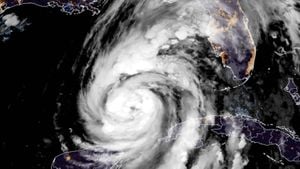Deep in the heart of South America lies the Amazon rainforest, often referred to as the 'lungs of the Earth.' This vast expanse of tropical forest plays a pivotal role in regulating the Earth’s climate by absorbing large amounts of carbon dioxide and maintaining atmospheric moisture. However, it is currently teetering on the edge of a catastrophic transformation due to deforestation and climate change. Research led by D. V. Spracklen and C. A. S. Coelho highlights the urgency of this issue by investigating the early warning signs of Amazon forest dieback through a combination of innovative modeling and historical data analysis.
The Amazon rainforest is not just another forest; it’s a complex and interdependent ecosystem crucial to the planet's health. Spanning over 5.5 million square kilometers, it houses millions of species, many of which are still undiscovered, and plays a significant role in carbon storage and water cycling. Yet, nearly 20% of the Amazon has already been deforested, primarily for agriculture and logging. This deforestation reduces the rainforest’s ability to pump moisture into the atmosphere, leading to declining rainfall and creating a feedback loop that further exacerbates forest loss. As one might say, it’s like stripping away the insulation of a house in the middle of winter – the warmth (or in this case, moisture) escapes, making the interior (the forest) increasingly vulnerable.
Deforestation is like removing blocks from a Jenga tower; each removal increases the chances of a collapse. Researchers warn that we might be nearing that collapse. According to the study, which uses a highly sophisticated dynamical model, the Amazon is approaching a tipping point where continued deforestation could lead to abrupt and potentially irreversible declines in rainfall. This model goes beyond traditional climate models by including crucial interactions between the vegetation, soil, and atmosphere, thus offering a more accurate representation of the forest-climate system.
One of the novel aspects of the model is its focus on the feedback loops between vegetation and atmospheric moisture. As deforestation increases, it reduces evapotranspiration – the process by which moisture is transferred from the land to the atmosphere by evaporation from the soil and transpiration from plants. This loss of moisture not only decreases local rainfall but also affects the inflow of atmospheric moisture. As deforestation reaches a critical threshold, the model predicts an abrupt decline in rainfall – by as much as 30 to 50%. It’s akin to a domino effect where once enough dominos (trees) are knocked over, the whole system crumbles rapidly.
Historical climate data reinforces these alarming predictions. Over the past 40 years, soil moisture across the Amazon has declined, accompanied by a lengthening of the dry season by 5 to 15 days. It’s a telltale sign that the forest is already under significant stress. This research aligns with previous theories such as the "Biotic Pump," which posits that forests help drive atmospheric moisture transport, thus maintaining regional climates. Loss of forest cover means weakening this critical pump, further diminishing rainfall.
Let’s dive into the modeling techniques used in this study. Unlike traditional climate models, which often use somewhat broad assumptions due to their global scale, this model zeroes in on the Amazon with detailed parameters. It simulates the movement of air parcels across the forest, incorporating interactions between vegetation, soil moisture, and atmospheric dynamics in a more nuanced manner. For example, the model accounts for how tree mortality occurs when soil moisture falls below a certain threshold. This approach allows researchers to more precisely identify tipping points and feedback loops that might be missed in broader climate models.
The model reveals that the Amazon’s climate system is much more sensitive to deforestation than previously thought, primarily due to these vegetation-climate feedback loops. Including these feedbacks moves the critical threshold for deforestation closer, suggesting that widespread forest loss could occur much sooner than current global models predict. This is a wake-up call for policymakers and conservationists.
But what are the broader implications of this research? For one, it underscores the need for more accurate and region-specific climate models. While global climate models are essential for understanding overall trends, they can sometimes gloss over critical regional dynamics like those in the Amazon. The study suggests that policymakers should not rely solely on global models when making decisions about deforestation policies and climate mitigation strategies.
Moreover, this research could have significant implications for global carbon budgets and climate targets. The Amazon acts as a massive carbon sink, absorbing millions of tons of CO2 annually. If it were to reach the tipping point and undergo widespread dieback, the resulting CO2 release would be devastating for global efforts to limit warming to 1.5 degrees Celsius. It would also disrupt weather patterns far beyond South America, affecting agricultural productivity and water availability worldwide.
Addressing the underlying mechanisms behind the findings, it’s essential to understand that the Amazon’s unique interplay between soil, water, and vegetation makes it particularly vulnerable to feedback loops. Just like an intricate machine with many interlocking parts, removing or damaging one component (trees, in this case) can have cascading effects on the entire system. The study highlights the importance of preserving large contiguous areas of forest to maintain these critical feedback mechanisms.
However, no study is without its limitations. The authors acknowledge that their model, like all models, makes certain assumptions that could affect the results. For instance, it’s uncertain how increased CO2 levels in the future might impact forest resilience. There’s also a degree of variability in how different areas of the Amazon might respond to deforestation. Additionally, while the model incorporates many critical interactions, it still simplifies some aspects of the ecosystem that might influence the outcomes.
Future research will need to address these limitations by incorporating more real-world data and refining the model’s parameters. One exciting avenue is the Amazon Free-Air Carbon Dioxide Enrichment (AmazonFACE) experiment, which aims to study how increased CO2 concentrations might affect the Amazon. This experiment will provide vital data to help fine-tune models and improve predictions about the forest’s future.
Furthermore, advancements in computing power will enable even more detailed simulations. As climate models evolve to run at higher resolutions, they can more accurately capture the complex interactions between air, land, and water. This will be crucial for understanding not just the Amazon but other critical ecosystems worldwide.
In conclusion, the study by Spracklen and Coelho serves as a stark reminder of the fragility of the Amazon rainforest and the urgent need for action. As the authors eloquently put it, we are at a critical juncture: "Each year, more of the Amazon is cleared, pushing the system closer to this unknown threshold." It’s a call to arms for policymakers, scientists, and the global community to take decisive steps to protect this invaluable ecosystem before it’s too late.
Preserving the Amazon is not just about saving trees; it’s about safeguarding the future of our planet. The forest’s fate is intricately linked to global climate stability, biodiversity, and human well-being. As we move forward, let’s ensure that our actions reflect the gravity of the situation and our commitment to a sustainable future.



